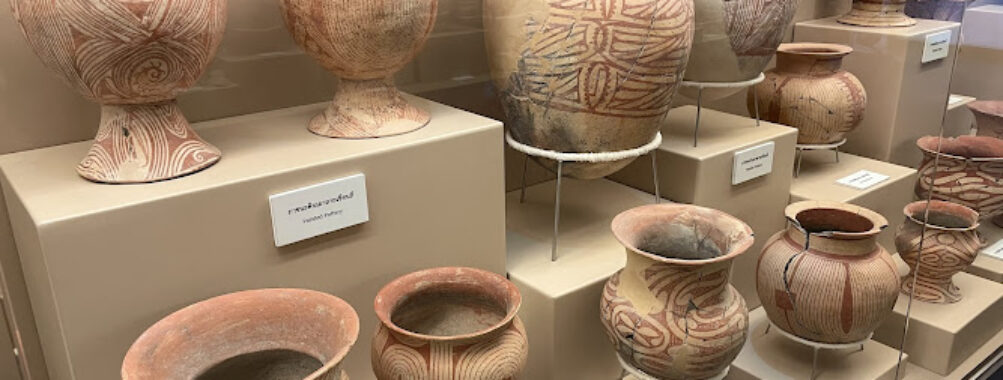
Ban Chiang National Museum
Table of Contents
Description
The Ban Chiang National Museum in Udon Thani is one of those places that quietly sneaks up on you. At first glance, it looks like a small regional museum, but once you step inside, you realize you’re standing in front of some of the most important archaeological discoveries in Southeast Asia. This UNESCO World Heritage Site isn’t just about old pots and shards of clay—it’s about a story that stretches back more than 5,000 years, right into the Bronze Age.
What makes it fascinating is how personal it feels. The museum doesn’t overwhelm you with endless rows of artifacts; instead, it curates them in a way that helps you imagine what life was like for the people who once lived here. You’ll see pottery painted with swirling red designs, ancient tools that were once held in human hands, and even jewelry that still carries a sense of beauty despite its age. Dioramas bring the prehistoric village to life, showing how people cooked, worked, and buried their loved ones. It’s not hard to picture yourself in their shoes—well, sandals, probably.
Now, is it perfect? Not quite. Some displays feel a bit dated, and if you’ve visited larger museums in Bangkok or abroad, you might find the presentation less flashy. But that’s also part of its charm. It’s authentic, it’s grounded, and it doesn’t try to be something it’s not. You can wander slowly, take your time, and really absorb the history without jostling through crowds. And for travelers who enjoy digging a little deeper than the usual tourist stops, this museum is a gem worth the detour.
Key Features
- Exhibits of prehistoric pottery with distinctive red spiral designs
- Bronze Age tools, weapons, and ornaments that reveal early metalworking skills
- Jewelry and personal items that give a glimpse into daily life thousands of years ago
- Dioramas recreating scenes of prehistoric village life and burial traditions
- Wheelchair accessible parking and restrooms for inclusive travel
- Family-friendly environment with educational displays suitable for children
- Free parking on-site, making it easy for self-drive travelers
Best Time to Visit
The museum is open year-round, but the best time to visit depends on your tolerance for heat. From November to February, the weather in Udon Thani is cooler and far more comfortable for exploring both the museum and the surrounding archaeological site. If you come in the hot season, March through May, expect temperatures that can make walking around outside feel like stepping into an oven. Rainy season, from June to October, is less predictable—sometimes you’ll get a refreshing drizzle, other times a downpour that keeps you indoors. Personally, I’d say late morning in the cool season is perfect: you’ll beat the tour buses and still have enough daylight left to explore the village nearby.
How to Get There
Ban Chiang is about 50 kilometers from Udon Thani city, which means you’ll need to plan your transport ahead of time. There’s no direct bus that drops you at the museum’s doorstep, so most travelers either hire a taxi, join a tour, or rent a car. A taxi ride can feel pricey if you’re going solo, but if you’re traveling with friends or family, splitting the fare makes it much more reasonable. Driving yourself is straightforward—the roads are in good condition, and you’ll pass through small towns and rice fields along the way, which is a nice bonus.
If you’re the adventurous type, you can also rent a motorbike in Udon Thani and make the trip on two wheels. Just be prepared for the sun and traffic. Personally, I’ve done the drive by car, and I liked having the freedom to stop at roadside stalls for snacks and coffee along the way.
Tips for Visiting
First off, give yourself at least two to three hours here. The museum itself doesn’t take forever to explore, but if you rush, you’ll miss the little details that make it special. The pottery designs, for example, are hypnotic if you take time to really look at them.
Wear comfortable shoes because you’ll probably want to wander around the outdoor archaeological pits too. They’re not huge, but they add context to what you see inside. And don’t forget water—Udon Thani can get brutally hot, even in the cooler months.
Photography is allowed in most areas, but be respectful. Flash photography is usually discouraged, and honestly, the artifacts look better in natural light anyway. If you’re traveling with kids, this is a surprisingly good stop. The dioramas and the “real-life” feel of the displays tend to capture their imagination much more than a glass case full of coins or statues.
And here’s a personal tip: chat with the staff if you can. Even if their English isn’t perfect, they’re proud of this site and often share little insights you won’t find on the signs. One guide once told me about how local villagers used to stumble upon pottery fragments in their gardens before the site was formally excavated—it made the whole experience feel more alive.
Lastly, don’t skip the small shops around the museum. You’ll find handmade pottery inspired by the ancient designs, and while it’s obviously not 3,000 years old, it makes for a meaningful souvenir that connects you to the history you’ve just walked through.
Location
Places to Stay Near Ban Chiang National Museum
Find and Book a Tour
Explore More Travel Guides
No reviews found! Be the first to review!